Find out how to choose a non toxic, beautiful rug for your healthy home! Plus, learn how to care for your non toxic rug to keep it clean and new.
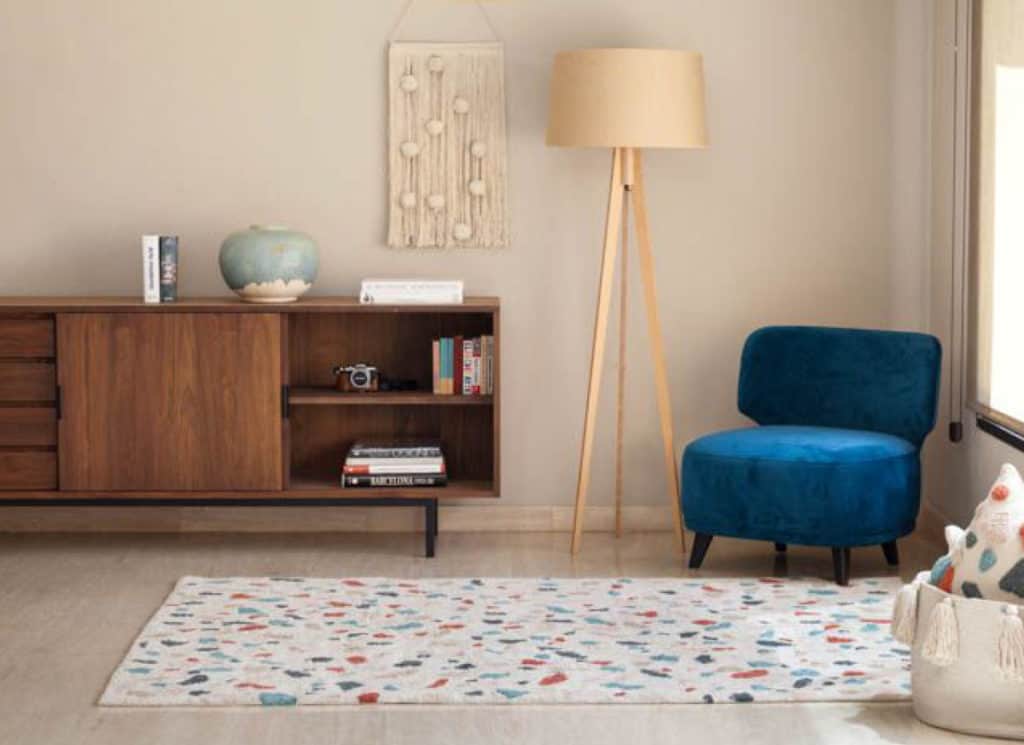
An attractive area rug is a must-have in each room of my home. What can I say? Both my undergraduate and graduate degrees are in interior design. My home’s aesthetic is a priority for me.
But a healthy home is also a priority, especially with my daughter running around barefoot and playing on our rugs. Which is why 3 years ago when I was pregnant, I went on a hunt for beautiful, non-toxic rugs to decorate my home.
When I first started my search for creating a non-toxic home (you can click here to read more about how to create a healthy home!), I found area rugs to be a heavy hitter in the toxic burden of the average house. Honestly, healthy homes isn’t a widespread topic on the internet these days, which meant I had to look at tons of resources, and even enroll in several healthy home courses from Parson’s School of Design.
Lucky for you, I did the research and am here to share my findings. This is a complete guide to using non-toxic rugs to make a healthy, beautiful home.
Are eco-friendly rugs the same as non-toxic rugs?
First things first, let’s define some terms. Eco-friendly rugs are not necessarily non-toxic rugs, and vice versa. While an eco-friendly rug focuses on the health of our planet, non-toxic rugs focus on the health of the humans that come into contact with it.
Don’t fall for greenwashing
“Eco-friendly,” “green,” and “sustainable” are marketing buzzwords you’ll likely come across when searching for non-toxic rugs. These are great qualities if you’re looking to help our planet, but they don’t necessarily indicate the rug is safe for your health. For your health, you’ll have to search for non-toxic rugs first and then consider the eco-friendly aspect.
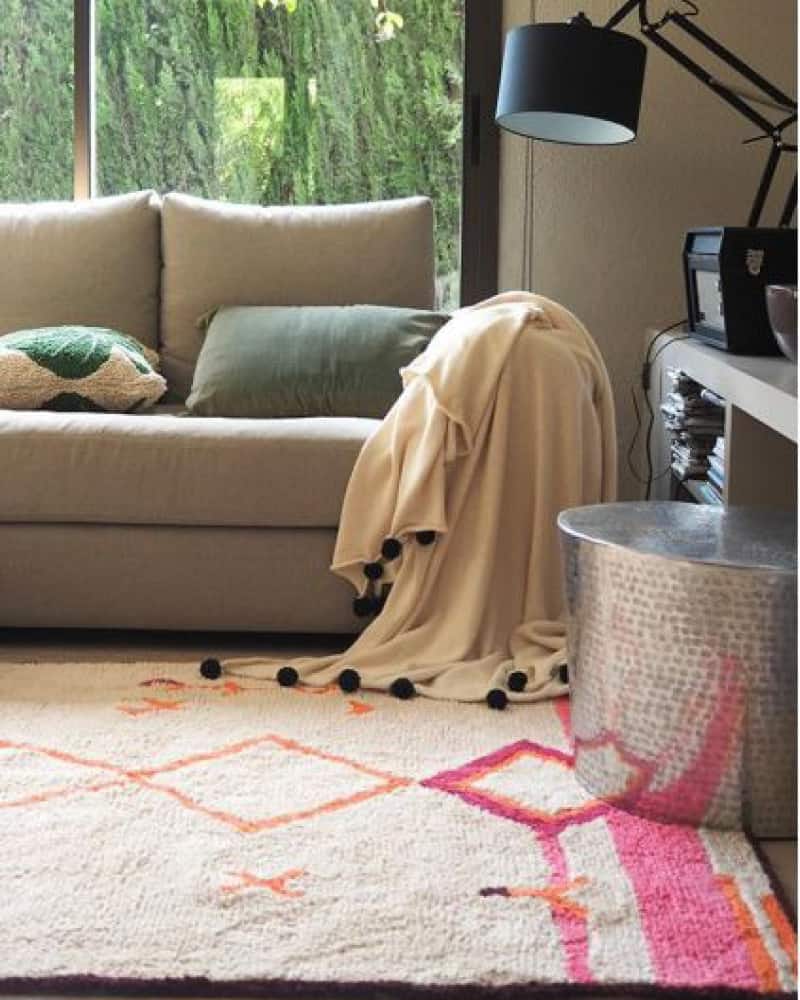
What should I avoid in a rug?
Again, be careful about falling for marketing. A rug with only one safer component, like a natural material, might be marketed as non-toxic. This is how you’ll find supposedly non-toxic rugs at big box stores for really cheap prices. But there’s a catch:
For example, I learned wool rugs require extra harsh dyes to color the fibers since wool is naturally stain resistant. Despite checking so many of the boxes for a safer solution, it had one factor that counteracted all of them, and it ended up contributing to the toxic burden of our home.
You’ll be able to make a much more educated choice if you know what to avoid. Here are the main toxic offenders to avoid in your rugs:
- Materials like polypropylene (also known as olefin or polyolefin), nylon, and polyester. These three are synthetic materials that are created through chemical processes. Synthetic materials aren’t necessarily always harmful but can transfer chemicals to the skin depending on how it’s produced.
- Flame retardant chemicals are incredibly toxic, not very effective, and almost always applied to the synthetic materials listed above.
- Natural materials like cotton and wool can also be an issue. These materials often are sprayed with pesticides and other chemicals when not properly sourced.
- The synthetic rubber backing of rugs and rug pads can contain endocrine-disrupting ingredients.
- Many rugs use toxic, high-impact dyes to color the fibers.
- Formaldehyde, a probable carcinogen and ear, nose, and throat irritant, is found in adhesives used to make many building products and furniture including area rugs.
- Stain and water repellent treatments are often made from perfluorinated compounds (PFCs). This chemical is known to get into the bloodstream and has been found in human breast milk.
The affordable non-toxic rugs I use in my home
Yes, choosing a safer rug option can set you back a bit more. But it doesn’t have to every time! By making smart design choices and choosing these more affordable non-toxic rug brands, you can keep your wallet happy.
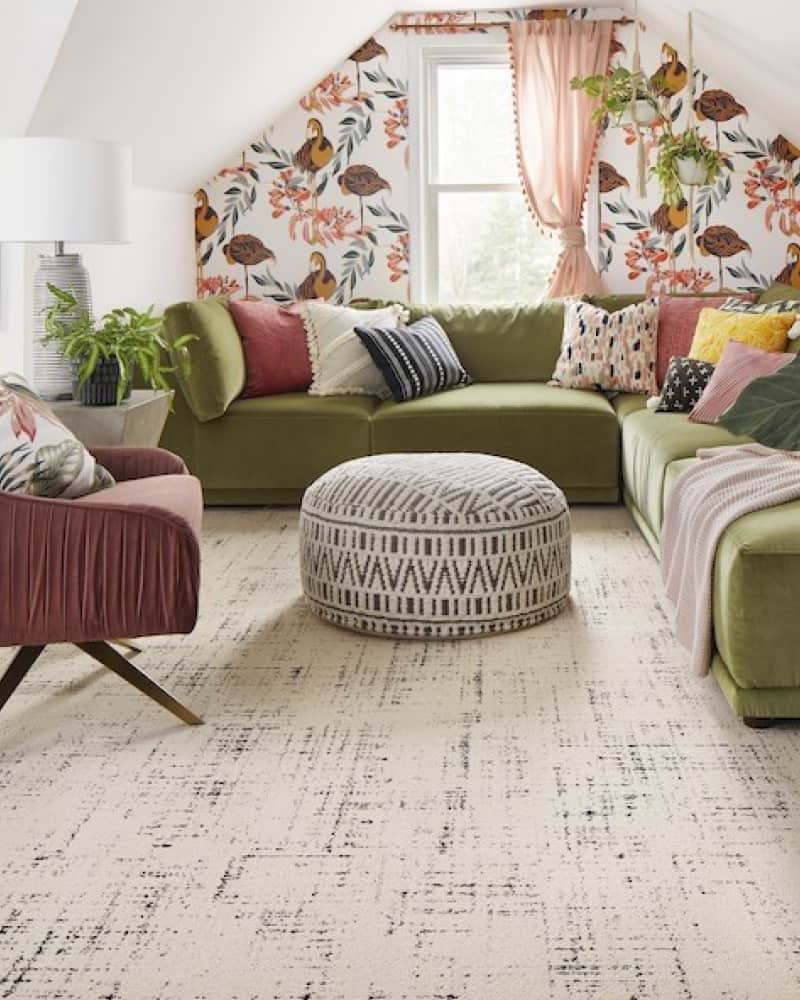
FLOR
These durable and stylish carpet tiles are odor-free, eco-friendly, and fairly affordable. Price ranges from $8-32 per tile. You’ll need 12-30 tiles depending on the size, so it can add up quickly if you’re needing a larger rug.
Safavieh
This popular brand offers a range of non-toxic options in beautiful styles, but you’ll need to do some searching. Here are some ways to choose a non-toxic Safavieh rug:
- Filter the rugs by natural materials like wool, cotton, and sisal. Be sure to double check your selected rug, because I found that some synthetic rugs still snuck in even when filtered.
- Contact Safavieh’s customer service team to fully vet a rug you’re considering. Be sure to ask if they use any fire retardants or stain repellents on the rug.
I chose this one from Safavieh and have been super happy with it! It works best in a lower traffic area since it’s cotton. Cotton won’t have the same durability or natural stain resistance as wool.
Hook & Loom
This brand offers simple, affordable choices like large jute rugs. These are perfect on their own or, as one of my favorite interior design tricks, layered beneath a smaller, more complex rug. My favorite way to layer Hook & Loom rugs is with a Lorena Canal rug on top.
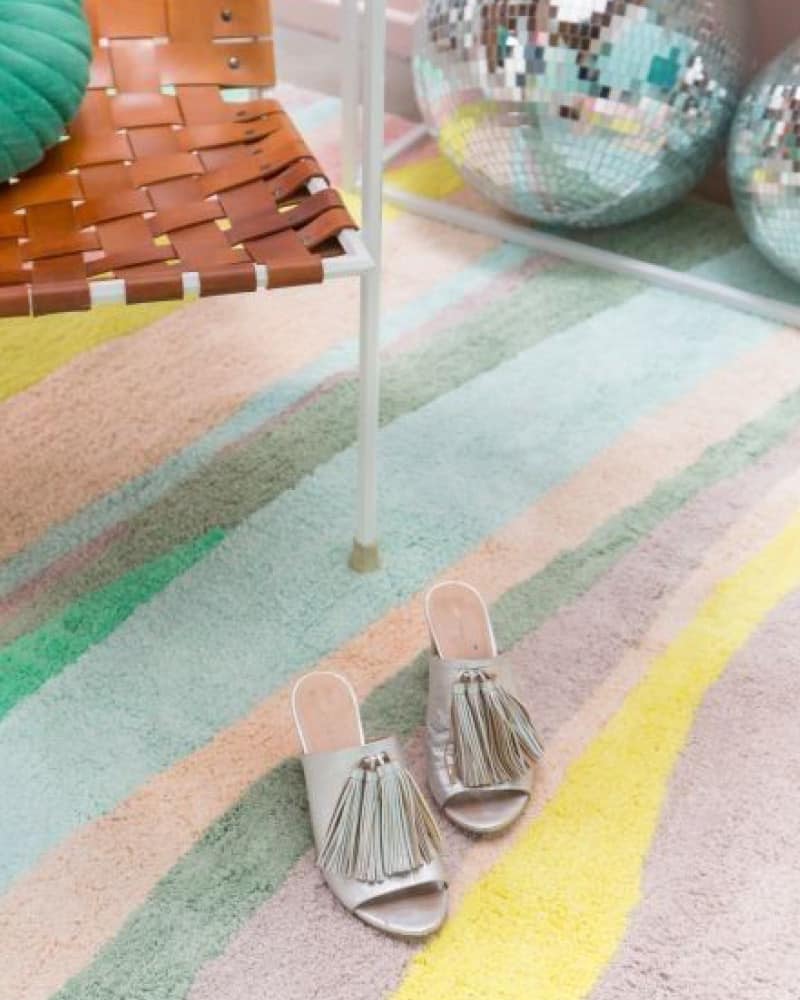
Lorena Canal
Don’t let this brand fool you, it’s not just for kids! While they do have plenty of adorable kid friendly options, they also have simple and mature styles for kid-free spaces.
How to care for your non-toxic rug
So you’ve made the leap and purchased a non-toxic rug–yay! Here are some tips for keeping your new investment safe and secure:
Use a rug pad
A rug pad is essential to prevent slipping and to help maintain your rug. Avoid toxic options found at most stores and spring for a felt or wool one like this one. Alternatively, choose a 100% natural latex pad like this one.
Don’t use the vacuum brush roll
When vacuuming your rugs, be sure to use the ‘hardwood’ setting. Using the brush roll is usually unnecessary, unless it’s shedding or seriously dirty.
Remove shoes at the door
Only walk on your rugs with bare feet or house shoes. This tip is twofold: you’ll also limit the pesticides and pathogens you’re tracking into your home!
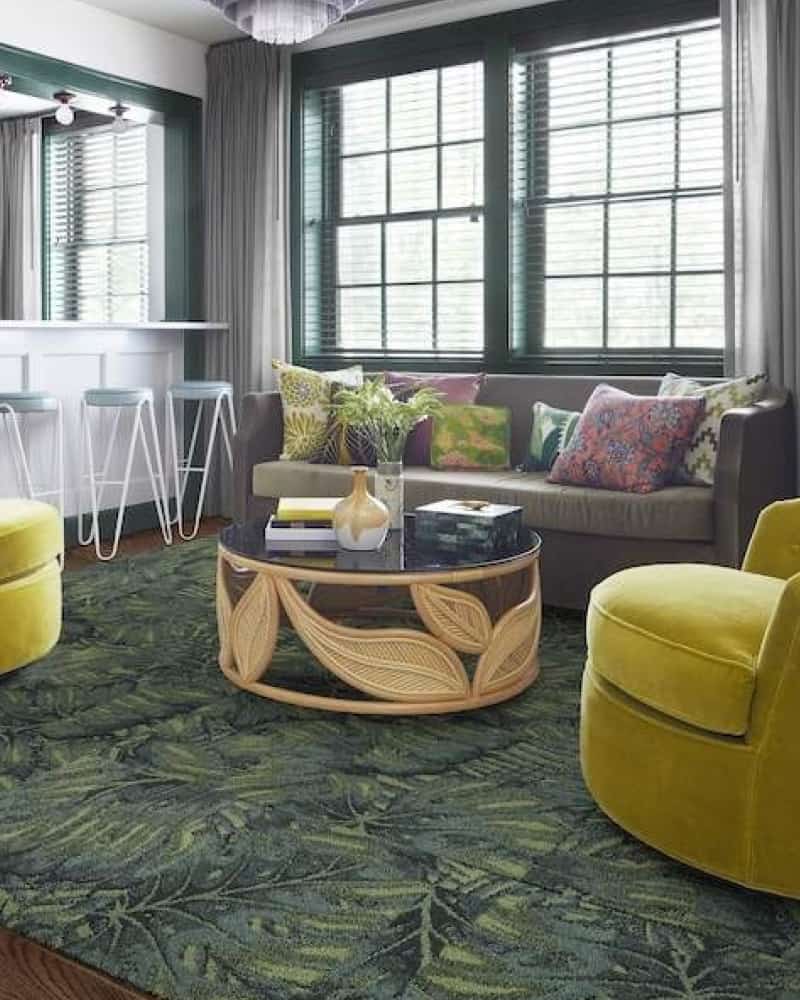
What if my rug isn’t completely non-toxic?
Sometimes a 100% non-toxic rug just isn’t in the budget. Totally fine–as I say, it’s about progress, not perfection. If you can find a rug that’s even slightly safer than a conventional rug, that’s better than nothing. And if you can still only use your conventional rugs, no worries–here’s some tips for what to do if your rug isn’t totally non-toxic.
Allow it to off-gas
Off-gassing, or the emission of chemicals from a toxic item, can contribute to health issues and cause irritation. For this reason, I suggest allowing your rug to off-gas outside in the sunlight as long as possible. This keeps the off-gassing emissions out of your home and helps speed up the process so the chemicals are diminished faster.
Absorb some of the chemical odors
A great way to get rid of that noxious, chemical-y smell is sprinkling baking soda on your rug and allowing it to absorb the smell overnight. Vacuum in the morning!
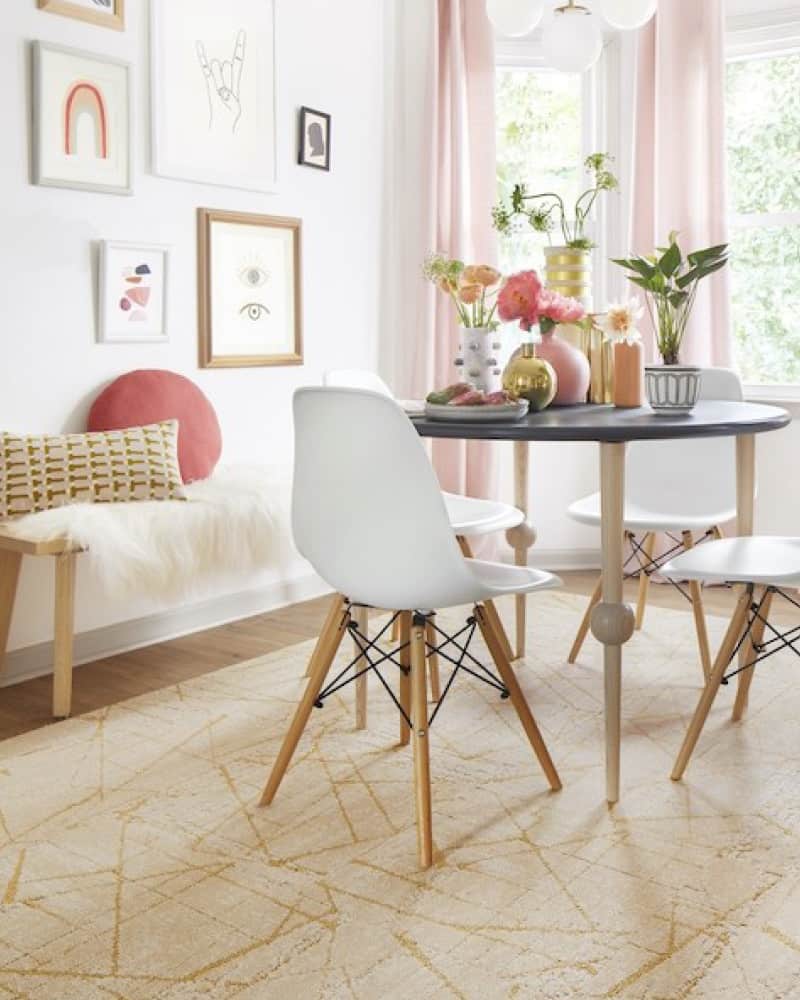
Whether you choose a large area rug or a small hallway runner, it’s important to your family’s health that you go with a safer rug. Rugs are some of the biggest toxic offenders in a home and can off-gas for years.
Luckily, there are tons of non-toxic rug options out there. Choosing a safer rug that fits your budget is an important step in making your home a healthy one!



Where is that green sectional couch from? It looks so comfy judging by the size of the cushion!
Thank you for sharing your knowledge and expertise. We need to purchase some rugs and I’m allergic to formaldehyde.
I’m not a rug or blanket. I’m Hella Lottafun! 🦊💍🗝️⚪💚⚫♊👁️🗨️💟🇺🇲
This article is so helpful! I share it with everyone who asks me where to buy non toxic rugs!